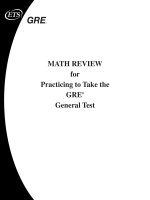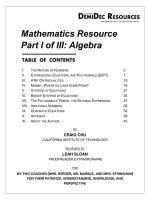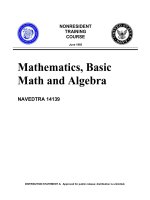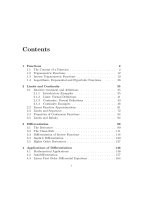Math ebooks abst 2301337
Bạn đang xem bản rút gọn của tài liệu. Xem và tải ngay bản đầy đủ của tài liệu tại đây (143.44 KB, 17 trang )
CHAPTER I
Groups
1.1
Definitions and Examples
Definition 1.1.1. A binary operation ∗ on a set S is a function from S × S
into S. (S, ∗) is then called a binary structure.
Definition 1.1.2. Let ∗ be a binary operation on a nonempty set S.
∗ is associative
if (a ∗ b) ∗ c = a ∗ (b ∗ c) ∀a, b, c ∈ S
∗ is commutative if
a∗b=b∗a
∀a, b ∈ S.
An element e of S is an identity element for ∗ if
e∗x=x=x∗e
∀x ∈ S.
Definition 1.1.3. A binary structure (S, ∗) is called a semigroup if ∗ is associative. A monoid is a semigroup that has an identity element.
Definition 1.1.4. A monoid (G, ∗) with the identity element is said to be a group
if for each a ∈ G, there is b ∈ G such that
a ∗ b = e = b ∗ a.
This element b is called an inverse of a.
Remark. It is customary to denote a group (G, ∗) by its underlying set G and
x ∗ y by xy if there is no ambuguity.
2
Definition 1.1.5. The order of a group G is the cardinality of the set G and
denoted |G|.
Definition 1.1.6. A group (G, ∗) is a abelian if ∗ is commutative (ie. a ∗ b =
b∗a
∀a, b ∈ G).
Theorem 1.1.7. Let (G, ∗) be a semigroup. Then the following are equivalence
(i) (G, ∗) is a group.
(ii) there is e ∈ G such that e a = a for all a ∈ G, and for each a ∈ G, there is
a ∈ G such that a a = e .
(iii) there is er ∈ G such that aer = a for all a ∈ G, and for each a ∈ G, there
is b ∈ G, there is b ∈ G such that ab = er .
1.2
Elementary Properties of Groups.
Theorem 1.2.1. In any group G, the following hold:
(i) The identity element is unique.
(ii) Each element a of G has a unique inverse. It will be denoted a−1 .
Theorem 1.2.2. Let a, b and c be elements of a group. ab = ac or ba = ca
implies b = c.
Theorem 1.2.3. Let a and b be elements of a group G.
(i) e−1 = e.
(ii) (a−1 )−1 = a.
(iii) (ab)−1 = b−1 a−1 .
3
Notation. For each element a in a group G,
a0 = e,
a1 = a
an+1 = (an )a
a−n = (a−1 )n
for all n ∈ N
for all n ∈ N
Theorem 1.2.4. Let a and b be elements of a group.
(i) (an )−1 = (a−1 )n (= a−n ) for all n ≥ 0.
(ii) am an = am+n for all m, n ∈ Z.
(iii) (am )n = amn for all m, n ∈ Z.
(iv) If ab = ba, then (ab)n = an bn for all n ∈ Z.
Theorem 1.2.5. Let G be a group and a ∈ G. If n is the smallest positive integer
such that an = e, then
ak = e if and only if n | k.
Theorem 1.2.6. Let a and b be elements of group G.
(i) The equation ax = b has a unique solution x = a−1 b.
(ii) The equation xa = b has a unique solution x = b−1 a.
4
1.3
Subgroups
Definition 1.3.1. If a subset H of a group G is itself a group under the operation
of G, we say that H is a subgroup of G, denoted H ≤ G.
Theorem 1.3.2. Let H be a subset of G. TFAE
(i) H is a subgroup of G.
(ii) ab ∈ H for all a, b ∈ H and a−1 ∈ H for all a ∈ H.
(iii) ab−1 ∈ H for all a, b ∈ H.
Theorem 1.3.3. Let H be a nonempty finite subset of a group G. If H is closed
under the operation of G, then H ≤ G.
Theorem 1.3.4. Let a be an element of a group G. Then
a = {an | n ∈ Z}
is the smallest subgroup of G containing a. It is called the cyclic subgroup of
G generated by a.
Definition 1.3.5. Let a be an element of a group G. The order of a, denoted
◦(a) is the smallest positive integer n such that an = e (if it exist). If no such
that integer exists, we say that a has infinite order.
Theorem 1.3.6. Let G be a group and a ∈ G. Then | a | = ◦(a). In particular
{e, a, a2 , . . . , an−1 }
if ◦ (a) = n,
a =
{. . . , a−2 , a−1 , e, a, a2 , . . . } if ◦ (a) is infinite.
5
Theorem 1.3.7. Let a be an element of order n in a group G. Then
(i) ak = e if and only if n | k.
(ii) ak = am if and only if k ≡ m mod n.
Theorem 1.3.8. The center of a group G, Z(G)
Z(G) = {g ∈ G | gx = xg for all x ∈ G}
is a subgroup of G.
Theorem 1.3.9. Let H and K be subgroups of a group G. Then
|HK| =
|H||K|
.
|H ∩ K|
Theorem 1.3.10. Let H and K be subgroups of a group G. Then HK is a
subgroup of G if and only if HK = KH.
1.4
Homomorphisms and Isomorphisms
Definition 1.4.1. Let (G, ◦) and (G , ∗) be groups. A mapping φ : G → G is
called a homomorphism if
φ(a ◦ b) = φ(a) ∗ φ(b) for all a, b ∈ G.
Definition 1.4.2. Let φ : G → G be a group homomorphism. The kernel of φ,
denoted Ker φ is defined by
Ker φ = {g ∈ G | φ(g) = e }
where e is the identity element of G .
6
Definition 1.4.3. A bijective (1-1 and onto) homomorphism is called an isomorphism. G and G is then said to be isomorphic, denoted G ∼
= G . An
isomorphism from a group G into it self is called an automorphism. The set of
all automorphisma is denoted by Aut(G).
Isomorphism preserves algebraic property e.g. order of group, order of
element, commutativity etc.
Theorem 1.4.4. For any group G, Aut(G) is a group under composition.
Theorem 1.4.5. The isomorphism relation ∼
= is an equivalence for groups.
Theorem 1.4.6. Cayley’s Theorem
Every group is isomorphic to a subgroup of a permutation group. If a group is of
order n, then it is isomorphic to a subgroup of Sn .
1.5
Cyclic Groups and generators
Definition 1.5.1. A group G is called a cyclic group if G = a for some a ∈ G.
a is then called a generator of G.
Theorem 1.5.2. Every cyclic group is abelian.
Theorem 1.5.3. A subgroup of a cyclic group is cyclic.
Theorem 1.5.4. Let G = a be a cyclic group of order n.
(i) | as | =
n
where d = g.c.d.(n, s), 0 < s < n.
d
n
(ii) If k|n, then a k is the unique subgroup of G of order k.
(iii) The set of generators of G is {ak | g.c.d.(n, k) = 1}.
7
Theorem 1.5.5. (i) (Z, +) is the only infinite cyclic group.
(ii) (Zn , +) is the only cyclic group of order n.
Definition 1.5.6. Let X be a nonempty subset of a group G. The smallest subgroup of G containing X, denoted X is called the subgroup of G generated
by X.
Theorem 1.5.7. Let X be a nonempty subset of a group G. Then
X = {xk11 xk22 . . . xknn |xi ∈ X, ki ∈ Z, n ≥ i}.
Definition 1.5.8. A group G is called finitely generated if there is a finite
subset X of G such that G = X . We call X a set of generators for G. If X is
finite, G is called a finite generated group and denoted G = x1 , x2 , . . . , xn .
Theorem 1.5.9. Let σ : G → G1 and τ : G → G1 be homomorphism. Assume
that G = X . Then
σ = τ if and only if σ(x) = τ (x)
for all x ∈ X.
A group homomorphism σ : X → G1 is completely determined by its effect
on X.
8
1.6
Direct Products
Theorem 1.6.1. Let G1 , G2 , . . . , Gn be groups. Then G1 × G2 × · · · × Gn is a
group under the componentwise operation, that is
(a1 , a2 , . . . , an )(b1 , b2 , . . . , bn ) = (a1 b2 , a2 b2 , . . . , an bn ).
This group is called the (external) direct product of G1 , G2 , . . . , Gn .
Theorem 1.6.2. Let G1 , G2 , . . . , Gn be finite groups and (g1 , g2 , . . . , gn ) be an
element of the group G1 × G2 × · · · × Gn . Then
◦ ((g1 , g2 , . . . , gn )) = l.c.m.(◦(g1 ), ◦(g2 ), . . . , ◦(gn )).
Theorem 1.6.3. Let G1 and G2 be finite cyclic groups. Then G1 × G2 is cyclic
if and only if |G1 | and |G2 | are relatively prime.
Corollary 1.6.4. The external direct product G1 × G2 × · · · × Gn is cyclic if and
only |G1 |, |G2 |, . . . , |Gn | are pairwise relatively prime.
Theorem 1.6.5. Let H and K be subgroups of a group G. Assume that
(i) G = HK,
(ii) H ∩ K = {e},
(iii) hk = kh for all h ∈ H, k ∈ K.
Then G ∼
= H × K.
In this case, we say that G is the internal direct product of H and K.
9
Definition 1.6.6. Let H1 , H2 , . . . , Hn be subgroups of a group G. We say G is
the internal direct product of H1 , H2 , . . . , Hn if
(i) G = H1 H2 · · · Hn ,
(ii) (H1 H2 · · · Hi ) ∩ Hi+1 = {e} for i = 1, 2, . . . , n − 1.
(iii) hi hj = hj hi for all hi ∈ Hi , hj ∈ Hj , i = j.
1.7
Cosets and Lagrange’s Theorem
Definition 1.7.1. Let H be a subgroup of a group G and g ∈ G. The right
coset, Hg, of H generated by g and the left coset, gH, of H generated by g are
defined as follows :
Hg = {hg | h ∈ H} and gH = {gh | h ∈ H}.
Theorem 1.7.2. Let H be a subgroup of a group G and a, b ∈ G.
(i) Ha = H iff a ∈ H [aH = H iff a ∈ H].
(ii) Ha = Hb iff ab−1 ∈ H [aH = bH iff a−1 b ∈ H].
(iii) If a ∈ Hb, then Ha = Hb. [If a ∈ bH, then aH = bH].
(iv) Either Ha = Hb or Ha ∩ Hb = ∅ [Either aH = bH or aH ∩ bH = ∅].
(v) The set of distinct right(left) cosets of H is a partition of G.
(vi) The set of all distinct right cosets and the set of all distinct left cosets have
the same cardinality.
Definition 1.7.3. let H be a subgroup of a group G. The index of H, denoted
[G : H] is the cardinality of the set of all distinct right(left) cosets of H.
Lemma 1.7.4. Let H ≤ G and g ∈ H. Then
card Hg = card H = card gH.
10
Theorem 1.7.5. Lagrange
Let H be a subgroup of a finite group G. Then |H| divides |G|. In particular,
|G| = [G : H] · |H|.
Corollary 1.7.6. Let G be a group of order n.
(i) ◦(a) divides n ∀a ∈ G.
(ii) an = e ∀a ∈ G.
Theorem 1.7.7. let H and K be subgroups of a group G.
(i) If H ⊆ K, then [G : H] = [G : K][K : H].
(ii) If g.c.d(|H|, |K|) = 1, then H ∩ K = {e}.
1.8
Normal Subgroups and Factor Groups
Definition 1.8.1. A subgroup N of a group G is called a normal subgroup if
gN = N g for all g ∈ G. We write N ✁ G.
Theorem 1.8.2. Every subgroup of an abelian group is normal.
Theorem 1.8.3. Z(G) is normal in G.
Theorem 1.8.4. Let N be a subgroup of a group G. Then TFAE
(i) N is normal in G.
(ii) gN g −1 = N for all g ∈ G.
(iii) gN g −1 ⊆ N for all g ∈ G.
Theorem 1.8.5. If H is a subgroup of index 2 in G, then H is normal in G.
11
Theorem 1.8.6. Let N ✁ G and G/N = {N g | g ∈ G}. Then G/N is a group
under the operation
N a · N b = N ab.
This group is called the factor group(quotient group) of G by N . In addition,
|G|
if G is finite, then |G/N | =
= [G : H].
|H|
Theorem 1.8.7. Let N ✁ G.
(i) φ : G → G/N defined by φ(a) = N a is an onto homomorphism, called the
natural homomorphism
(ii) If G is abelian, then G/N is abelian.
(iii) If G = a , then G/N = N a .
(iv) H is a subgroup of G/N if and only if H = H/N for some subgroup H of
G containing N .
(v) HN is a subgroup of G for all subgroups H of G.
Theorem 1.8.8. Let G be a group. If G/Z(G) is cyclic, then G is abelian.
Theorem 1.8.9. Let H and K be subgroups of a group G.
(i) If H or K is normal in G, then HK = KH is a subgroup of G.
(ii) If H and K are normal in G, then HK is normal in G.
Theorem 1.8.10. Let H and K be normal subgroups of G and H ∩ K = {e}.
Then hk = kh for all h, k ∈ G. Consequently, G ∼
= H × K.
12
1.9
Cauchy’s Theorem and Conjugates
Definition 1.9.1. Let a and b be elements of a group G. b is said to be a conjugate of a if b = xax−1 for some x ∈ G.
Theorem 1.9.2. The relation ∼ defined on a group G by
a ∼ b if and only if b = xax−1 for some x ∈ G
is an equivalence relation on G. The equivalence class of a, denoted Cl(a) is called
a conjugacy class of a.
Theorem 1.9.3. Let G be a finite group. Then
|Cl(a)| = [G : CG (a)]
for all a ∈ G.
In particular, a ∈ Z(G) if and only if Cl(a) = {a}.
Theorem 1.9.4. Let G be a finite group and Cl(a1 ), . . . , Cl(an ) be distinct nonsingleton conjugacy classes in G. Then
n
|G| = |Z(G)| +
[G : CG (ai )].
i=1
Theorem 1.9.5. Cauchy’s Theorem
Let G be a group of order n . If p is a prime divisor of n, then G has an element
of order p.
Theorem 1.9.6. If G = {e} is a group of prime power order, then Z(G) = {e}.
Theorem 1.9.7. If G is a group of order p2 , where p is a prime, then G is abelian.
CHAPTER II
Isomorphism Theorems
2.1
Properties of homomorphisms
Recall that a mapping φ : G → G is called a homomorphism if
φ(xy) = φ(x)φ(y)
for all x, y ∈ G.
The kernel, Kerφ, of φ is φ−1 [{e}]. An isomorphism is a bijective homomorphism.
Theorem 2.1.1. Let φ be a homomorphism from a group G to a group G .
(i) φ(e) = e where e and e are identities in G and G , respectively.
(ii) φ(x−1 ) = (φ(x))−1 for all x ∈ G.
(iii) φ(x1 x2 · · · xn ) = φ(x1 )φ(x2 ) · · · φ(xn ) for all x1 , x2 , . . . , xn ∈ G.
(iv) If H ≤ G, then φ[H] ≤ G . In particular, Imφ is a subgroup of G .
(v) If H ≤ G, then Kerφ ⊆ φ−1 [H] ≤ G.
(vi) φ is 1-1 if and only if Kerφ = {e}.
Corollary 2.1.2. Let φ : G → G be a group homomorphism and g ∈ G.
(i) φ(g n ) = (φ(g))n .
(ii) If g has a finite order, then φ(g) has a finite order and ◦(φ(g)) divides ◦(g).
Theorem 2.1.3. if ψ : G → G is a group homomorphism, then Kerψ is a
normal subgroup.
14
2.2
Isomorphism Theorems
Theorem 2.2.1. First Isomorphism Theorem
Let φ : G → G be a group homomorphisms. Then G/Kerφ ∼
= Imφ.
Theorem 2.2.2. Second Isomorphism Theorem
Let H and N be subgroups of G with N normal. Then H ∩ N is normal in H and
H/H ∩ N ∼
= HN/N.
Theorem 2.2.3. Third Isomorphism Theorem
Let N ✁ G. then the map H → H/N gives a 1-1 correspondence between the set
of subgroups of G containing N and the set of subgroups of G/N .
Moreover, this correspondence carries normal subgroups to normal subgroups.
If H ✁ G and N ⊆ H ⊆ G, then
G/H ∼
= (G/N ) / (H/N ) .
CHAPTER III
Permutation Groups
3.1
Definitions and Notations
Definition 3.1.1. A permutation on a nonempty set X is a bijection on X.
The set S(X) of all permutations on X is a group under composition, called the
symmetric group on X. Any subgroup of S(X) is called a permutation
group on X.
Remark. If sets A and B have the same cardinality, then S(A) ∼
= S(B). When
X is finite, S(X) can be consider as the symmetric group on {1, 2, . . . , n}. It will
be denoted by Sn , called the symmetric group of degree n. The order of Sn
is n!. Sn is nonabelian where n ≥ 3. Each σ in Sn can be represented in matrix
from as
2
...
1
σ(1) σ(2) . . .
n
σ(n)
Theorem 3.1.2. Cayley’s Theorem
Every group is isomorphic to a permutation group.
16
3.2
Cycles
Definition 3.2.1. A permutation σ in Sn is a cycle if there exist a1 , a2 , . . . , ar
in {1, 2, . . . , n} satisfying
(i) σ(ai ) = ai+1 for all i ∈ {1, 2, . . . , r − 1},
(ii) σ(ar ) = a1 , and
(iii) σ(x) = x otherwise
r is then the length of the cycle. σ will be denoted by (a1 , a2 , . . . , ar ) and
sometimes refered to as r-cycle.
Remarks.
(i) The identity permutation is the only cycle of length 1 and will be denoted
(1).
(ii) (a1 , a2 , . . . , ar ) = (b1 , b2 , . . . , bs ) iff r = s and there exists t such that bi = at+i
for all i = 1, 2, . . . , r.
(iii) (a1 , a2 , . . . , ar )−1 = (ar , ar−1 , . . . , a1 ).
(iv) The order of r-cycle is r.
Definition 3.2.2. Let α = (a1 , a2 , . . . , ar ) and β = (b1 , b2 , . . . , bs ) be nonidentity
permutation in Sn . α and β are said to be disjoint if ai = bj for all i, j.
Theorem 3.2.3. Disjoint cycles commute.
Theorem 3.2.4. The order of a product of disjoint cycle is the l.c.m. of the
length of cycles.
17
3.3
Properties of Permutations
From now on permutations are in Sn where n ≥ 2.
Theorem 3.3.1. Every permutation is a cycle or a product of disjoint cycles. This
cycle decomposition is unique upto rearranging its cycles and cyclically permuting
the numbers within each cycle.
Definition 3.3.2. A 2-cycle is called a transposition.
Theorem 3.3.3. Every permutation is either transposition or a product of transpositions.
3.4
Alternating Groups
Lemma 3.4.1. The identity permutation is always a product of an even number
of transposition.
Theorem 3.4.2. If a permutation α is a product of an even number of transpositions, then every decomposition of α into a product of transpositions must have
an even number of transpositions. α is then called an even permutation.
Definition 3.4.3. A permutation which can be decomposed into a product of an
odd number of transpositions is called an odd permutation.
Theorem 3.4.4. The set of even permutations in Sn from a normal subgroup of
n!
order
of Sn called the Alternating group of degree n, denoted An .
2









